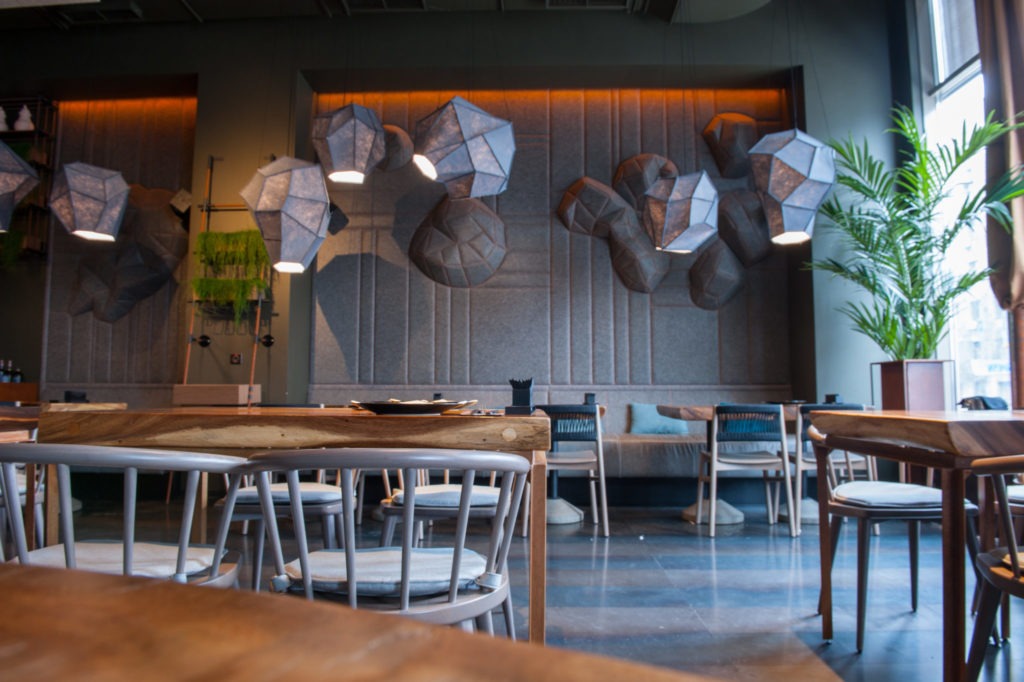Balancing noise levels in a restaurant is a delicate issue that deserves your utmost attention. The noise level in a restaurant influences everything from the atmosphere, dining experience and patrons’ perception of your space. Neither too much nor too little background noise is good for your business. Too much noise in the restaurant makes it difficult for patrons to conduct a conversation, while a too quiet dining room can make diners feel uneasy and worried about being overheard. In fact, uncomfortable noise levels in a restaurant and poor acoustics are often cited as one of the main reasons behind a poor dining experience, right after poor service. Controlling noise efficiently in a bar or restaurant is, therefore, crucial.
But how can you efficiently control noise in a restaurant? And what can you do to improve your bar or restaurant’s acoustics? Continue reading to find out more.
What causes too much noise in the restaurant?
Too much noise in your restaurant is detrimental to your business. Restaurants are social gathering and meeting spaces. And when diners are unable to hear each other over the table, you have already lost part of your customers. But what leads to restaurants becoming noisy? And why is poor restaurant acoustics such a common problem?
The answer to these questions might seem obvious at first. Someone must have turned on the music too loud. But the truth is, poor acoustics in a restaurant is often the result of inefficient or poor design. And a wide variety of restaurant design problems can lead to excessive noise in restaurants.
Modern interior design trends, with an emphasis on industrial-style and minimalist designs, are one of the main culprits behind poor restaurant acoustics. Hard surfaces and open ceilings reflect and amplify sounds, leading to an increase in noise levels inside. The lack of proper partitioning, open kitchen design and an overcrowded dining room can lead to the same effect. And when there is too much noise in a restaurant, diners will start raising their voice, amplifying the problems even further.
So how can you reduce noise and improve acoustics in your restaurant? Well, focusing on a few key areas in the restaurant design can help.
Focus on your restaurant’s ceiling design
Open ceiling designs and high ceilings are one of the main factors that contribute to poor acoustics in a restaurant. High-vaulted, open ceilings amplify and reflect sounds, making the dining room overly noisy. As a result, if you want to improve the acoustics in your restaurant, focusing on your restaurant’s ceiling design should be a top concern.
Depending on the overall restaurant design concept, you can use various types of ceiling treatments to reduce noise in a restaurant. One of the easiest and most efficient solutions is to install acoustic ceiling tiles that absorb sound and prevent echoes. If space permits it, reducing ceiling height and installing false ceilings might also be a great option.

Nonetheless, reducing ceiling height is not the only option. Acoustic tiles or wooden panels can also help deaden noise in the dining room. Coming in a great variety of shapes, colours, textures and materials, they are easy to match with any design and style.
Install carpeting in busy areas to reduce noise
Besides high ceilings, restaurant floors can be another major source of poor restaurant acoustics. Hard floor surfaces reflect and amplify sounds, and lead to excessive noise in the dining room. To avoid these problems, you can install carpeting, rugs or soft flooring materials in areas with high footfall.
Covering the entire floor with carpets might not be the best option from a design perspective. Nevertheless, installing carpets or using area rugs in specific areas of the restaurant can significantly improve your restaurant’s acoustics.
To achieve success, you will need to consider your restaurant’s layout and floor plan carefully. And while each restaurant’s floor plan is different, a few key areas worth considering include the reception and waiting area, the bar counter area, the service and cash stations as well as near the entrance to the kitchen and restrooms.
Add insulation and wall panelling to improve restaurant acoustics
Although professional ceiling and flooring design can greatly improve a restaurant’s acoustics, you should also pay attention to restaurant walls. Soundproofing your restaurants’ wall will reduce the amount of noise reflecting from them, improving the restaurants’ acoustics greatly. Fortunately, there are numerous design solutions possible if you want to soundproof your restaurant’s walls efficiently.

Depending on your restaurant’s design, theme and style, you can choose from various options to deaden unwanted sounds:
- Textile wall hangings and curtains. Thick fabric-covered wall panels, curtains and wall hangings absorb sounds in the dining room. You can opt for various colours, textures and patterns to enhance the interior design and give your space character.
- Soundproof paint. If you want to create more minimalist designs, you might also try covering your restaurant walls with soundproof pain. Soundproof or acoustic paint is a lot thicker than most standard paints, while soft pigments inside absorb sounds and prevent echo. As such, it might be a simple yet effective option to improve your restaurant’s acoustics.
- Wall panelling is another great way of reducing noise inside of restaurants. Digitally printed acoustic panels can enhance the interior design while also helping soundproof the place. For a more minimalist design, you can opt for wooden wall panels that break soundwaves and prevent echo.
- Greenery and decor. Greenery and other decorative elements can also be of great help. They can prevent sounds from travelling across the space, preventing excessive noise and echo. While improving your restaurant’s acoustics, they also help create a pleasant atmosphere.
Soundproof restaurant windows for better acoustics
If you want to improve acoustics in a restaurant, it is not enough to focus on the noises inside. Since most restaurants are located near busy roads or the high street, traffic noise can find its way into the dining room, ruining the experience. To control noise efficiently in a restaurant, it is therefore vital to limit the amount of noise entering the restaurant from the outside. Soundproof windows represent one of the main ways of achieving that.
Depending on your budget and goals, you can opt for various solutions. The simplest option is to use thick curtains, but it might not align well with the restaurant design. Instead, you can try installing acoustic laminated windows, or opt for double-glazed windows. Acoustic windows block sound by specially-designed interlays that block and reflect off sounds. Double-gazed windows, on the other hand, have two planes of glass separated by argon gas. The gases inside insulate noise and heat, offering superior insulating performance.
Efficient partitioning and seating design improve the acoustics in the restaurant
Large, open spaces can also contribute to excessive noise in the restaurant. Similarly, an overcrowded dining room, where patrons are seated close together can lead to increased noise in the restaurant. For this reason, it is crucial to establish proper partitioning and creating an efficient seating design for your restaurant.
While it might be tempting to cram as many tables in your restaurant as possible, leaving enough room between tables is crucial for enhancing acoustics. When diners are seated further apart, they won’t have to worry about being overheard and will allow them the intimacy they need to speak with their peers.
Similarly, choosing seating furniture with care can help improve acoustics in your restaurant. Booths, upholstered chairs and high back chairs absorb sound and reduce noise in a restaurant. To reduce the noise coming from moving chairs on the floor, you should also consider placing rubber caps on the legs of chairs.
Last, but not least, efficient partitioning of the restaurant areas is crucial. Partitions – either in the form of wall separators, or green walls – help give diners the privacy they need to feel comfortable and prevent them from being overheard. By breaking up the space, they prevent echo formation and improve the acoustics of the restaurant greatly.
Set the background music levels appropriately
Background music and ambient noisy are crucial in creating a pleasant atmosphere in your restaurant. Improving restaurant acoustics does not mean you completely silence the entire space. Rather, you want to create ambience noise and choose background music to suit your restaurants’ theme and concept.
There are various aspects to consider when creating a playlist for your restaurant. The type of music, the loudness and the tempo will all play a crucial role in diners’ perception of the space. And while there are no golden rules to follow, a few criteria are worth considering in order to create the best atmosphere in the restaurant:
- Loudness. When playing music in your restaurant, you want the music to be just loud enough got people to comfortably talk to their partners without being afraid of being overheard, but not too loud to tempt them to shout. The golden rule here would be to play music only so loud as to allow patrons to chat without having to speak over one another.
- Sound quality. Investing in high-quality loudspeakers is essential if you want to improve the acoustics in your restaurant. Cutting corners in this area will create unwanted noise, instead of lifting the ambience.
- Placement of speakers. A common design problem that leads to excessive noise is linked to the placement of loudspeakers in a restaurant. Avoid placing speakers facing one another, to avoid unwanted interference.
Need professional help to improve your restaurant’s acoustics?
Excessive noise in restaurants can seriously hurt the dining experience. And a large part of becoming and staying successful in the hospitality business depends on the customer experience. So investing time and effort into improving your restaurant’s acoustics and reducing noise in your restaurant is one of the best things you can do to enhance the quality of your services.
In today’s blog post we discussed the most common reasons for poor acoustics in restaurants. We hope that our tips will help you identify and remedy problems related to poor restaurant acoustics and excessive noise. And if you need professional help in implementing these strategies, you can always contact our team at Vision Shopfitters for help.
As one of London’s leading restaurant shopfitters and designers, we offer professional design and fit-out services for restaurants across the UK. With extensive experience in the hospitality industry, we can find creative and efficient ways to reduce noise in your restaurant and help you enhance the dining experience for your customers.
Are you looking for ways to reduce background noise in your restaurant? As one of London’s leading restaurant shopfitters and designers, we offer professional design and fit-out services for restaurants and can advise you on creating interiors that that impress. Working together with you, we can help improve your restaurant’s acoustics and bring to life designs that help you avoid unwanted noise. Contact our team to learn more.

